
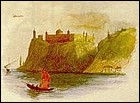



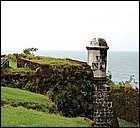

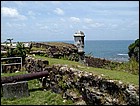

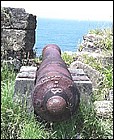

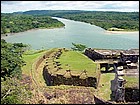



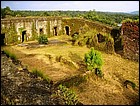

San Lorenzo
The fort at San Lorenzo was first built during the late 16th century (the actual year varies). King Philip II of Spain ordered a fortress to be built to overlook the mouth of the Rio Chagres which was heavily used by commerce and slaves ships. This entry was also the easiest route for marauding pirates and buccaneers looking for booty, and the location of the fort provided an excellent view of any approaching ships. Unfortunately, this first fort was made of wood and and began to deteriorate in the humid and rainy climate of Panama's six-month long rainy seasons. Between the rotting wood and the attacks by pirates, it began to deteriorate and eventually fell, helped along by the pirate and slaver, Francis Drake, who set fire to it in 1596.
The fort was eventually rebuilt but in 1671, it was captured by Joseph Bradley who was under orders from Henry Morgan, the infamous pirate. There were approximately 350 people stationed at the fort and in the battle, all but 30 died, with no officers being left alive. Bradley lost approximately 100 of his own men with many injured. Morgan arrived less than a week later and soon afterwards, Bradley died of his own wounds.
Morgan did not destroy the fort at this time but instead continued with his plans to destroy Panama Viejo ("Old Panama") by returning to the Pacific side. During this time, Portobelo (also spelled as Porto Bello), another important trading and treasure port, had also been attacked by pirates, including Morgan, and Spaniards alike, both whom had been waging a deadly battle for control due to it's important location on the coast. Another fort was established there by the Spaniards and some of the ruins remain standing today as they do at Fort San Lorenzo.
For weeks, Morgan raped and looted Panama, leaving nothing by stone ruins, and when his appetite was finally sated, he returned to Fort San Lorenzo where he and his men rested and regrouped. However, he also made the decision during this time to sail for Jamaica so when leaving, he set fire to what remained of the fort and burnt it to the ground. A year later, Morgan returned to England where he spent three years and after making friends with royalty, was appointed Acting Governor for the Duke of Albermarle and Lieutenant Governor of Jamaica, along with a number of other important offices. The Duke arrived in 1687 take over the governorship and Morgan died the next year in Port Royal.
The fort was rebuilt by the Spaniards in a slightly higher location, an odd-shaped cliff, this time using masonry. But records for the following years are sketchy, probably due to lack of any major battles at the site, so little information is known. But in March 1740, a British Admiral, Sir Edward Vernon, acting under orders from Britain to capture Portobelo and Fort San Lorenzo, bombarded the fort with his ship's cannons until the Spaniards gave up. After plundering the buildings and taking what they found, Vernon's men set fire to one of the buildings, destroyed the "castle" then sailed away for Portobelo.
In 1761, the fort was repaired and fortified but never again attacked by pirates. It gradually lost its importance as the years went by but in the first decades of the 19th century, after Panama gained its' independence from Spain but became the property of Colombia, it was once again in use but this time as a prison. When the 49ers poured into Panama with dreams of gold lying on the ground in California, it became a main traveling point for crossing the isthmus to Panama, where the 49ers needed to catch the ships to California. But it once again fell into obscurity when the Panama Railroad was completed and the travel routes changed.
It is what's left of the 1761 fort that is standing today, having been a part of history for over 400 years. When touching the stone walls of the fort and climbing through the ruins, one's imagination can only wonder if during these 400 years, other hands touched the exact same spots or tread through the same pathways or admired the same view. Standing at the farthest point to get a clear view of the Rio Chagres, you can close your eyes and know that you have a connection to history by just being there.
Ecotourist’s Paradise
The 12000-hectare San Lorenzo Protected Area (SLPA), located at the northwestern entrance to the Panama Canal, is currently part of the Mesoamerican corridor of protected areas extending from Guatemala to the Colombian border.
(SLPA), located at the northwestern entrance to the Panama Canal, is currently part of the Mesoamerican corridor of protected areas extending from Guatemala to the Colombian border.
The SLPA contains two forts built for similar protective functions: Fort San Lorenzo at the mouth of the Chagres River, first initiated by the Spanish in 1597 to protect the "Camino de las Cruces," the gold route over the isthmus; and Fort Sherman, started in 1911 to protect the northern entrance to the Panama Canal, the 20th century's "royal corridor" through Panama.
Both forts successfully fulfilled their military objectives, and Fort Sherman simultaneously protected the area's natural resources during the 20th century. SLPA's setting is at a major crossroads, historicaly connected with the Spanish conquest, the legacy of fortune seekers and the Chagres River including pirates and shipwrecks, the building of the Panama railroad, the efforts of France and the United States on the Panama Canal, and early agricultural activities.
The San Lorenzo Protected Area (SLPA) contains 3 ecological life zones, 12 vegetation types, and at least 500 species of higher plants. Nearly 590 species of vertebrates have been identified within the SLPA, including 36 species of amphibians, 35 reptiles, 435 birds, 81 mammals; moreover, the Chagres watershed and SLPA streams contain 42 species of freshwater fish.
Much of the fauna and flora of the SLPA are easily seen from roadsides and trails. The SLPA also has a variety of attractive scenery and is readily accessible by car. The picturesque historical and cultural attractions of the SLPA highlight Panama as the crossroads between two continents and two oceans.
The legacy of Spanish gold and Fort San Lorenzo, pirates, shipwrecks, the first “intercontinental railroad,” the French attempt at a the sea-level canal, and the building of the Panama Canal, Gatún Locks, and Fort Sherman, are all interwoven into the history of the SLPA.
Tourists will find both terrestrial and aquatic activities, including hiking along roads or trails, wildlife photography, bird watching, canoeing on the Chagres, kayaking, and fresh or saltwater fishing. The Caribbean shore, particularly west of Fort Sherman, offers quiet beaches, swimming, scuba diving, and snorkeling.
The sandy coves and wooded ridges bordering the Caribbean shore provide glimpses of passing vessels and views of the city of Colón across Limón Bay. Along the Gatún Locks- Sherman Road, the principal thoroughfare of the SLPA, wetland forests (mangrove, Pterocarpus, and cativo swamps) and typical flora (mangrove ferns, large trees, and heliconias) are readily visible from vehicles.
Monkeys, sloths, and anteaters are often seen, as are several species of birds, lizards, and butterflies, including the iridescent blue morpho (Morpho peleides). At Fort Sherman, viewing the architecture of the residences, administration buildings, and World War I batteries provides insights into military life during the 20th century.
Hikers venturing along gravel roads and trails into the interior encounter panoramas from rugged highpoints and occasional views of waterfalls, small caves, and some of the more timid fauna of the SLPA. A short distance away, the Panama Canal and Gatún Locks, traversed by ships from all over the World, add to a memorable experience

